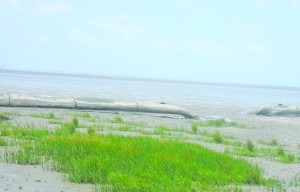
The Agriculture Ministry has invested in several new innovations to enhance the growth of mangroves along the country’s coastland. During a tour along the East Coast of Demerara last Thursday, Agriculture Minister Dr Leslie Ramsammy visited some of the mangrove planting sites at Mon Repos, Buxton, Victoria and from Le Ressouvenir to La Bonne Intention (LBI).
From Le Ressouvenir, luscious mangroves were seen along the coast all the way to LBI, where a new species of mangroves is growing.
The new species of mangrove is called “white mangroves” and its leaves are different from “black mangroves”, which is the dominant vegetation found on the coast.
Minister Ramsammy explained that the white mangroves grow naturally and are a recessive mutation of the black mangroves.
At Mon Repos, the ‘rubble mound’ had been set up. The mound is a layer of bricks used to reduce the force of the waves from the ocean. At this site, spartina grass is being used to prevent the mud, facilitating the growth of mangroves. Several such structures have been built at sites across the country.
The minster told media operatives that spartina grass is found mostly in West Berbice and plays a major role in the growth of mangroves in areas where they have failed to take root in the past.
According to the engineers working on the mangrove programme, the grass has grown significantly over the past three months and is assisting with the natural regeneration of mangroves.
Scientific methods
Minister Ramsammy noted that growing mangroves is not an easy task, as it requires a lot of science and that is where the engineers come in. They experiment on different innovations to find what works.
The programme falls under the government of Guyana in an effort to promote and sustain mangroves along the country’s coastlands.
The tour culminated at Victoria where the geotextile project is located. This project functions like the ‘bushwood dam’ whereby tubes have been inserted into the mud to break the force of the waves, encouraging sedimentation.
The agriculture minister detailed that the combination of the geotextile project and the usage of the spartina grass will encourage the growth of mangroves.
Young mangroves were already sprouting from the ground at the site.
Minister Ramsammy said there were some 14 sites across Guyana where mangroves were being grown, but only 50 per cent of them are successful, hence the implementation of these innovations.
He noted that these innovations form part of the coastal engineering work in Guyana, along with the seawall and other structures.



